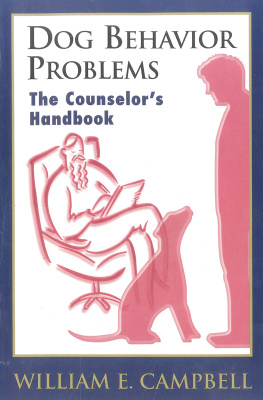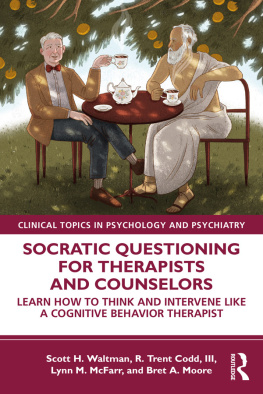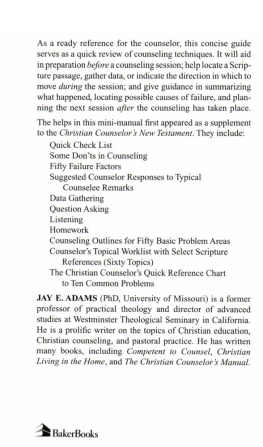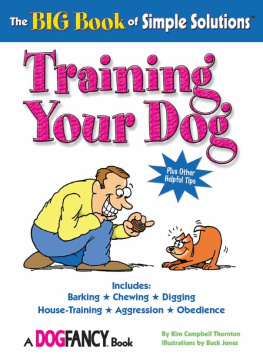
Copyright 1999 by William E. Campbell Copyright under the International Copyright Union. All rights reserved. This book is protected by copyright. No part of it may be reproduced, stored in a retrieval system or transmitted by any means, electronic, mechanical, photocopying, recording or otherwise, without written permission from the author or publisher.
While every effort has been made to ensure the accuracy of information contained herein, the publisher and author are not legally responsible for errors or omissions.
Library of Congress Catalog Card Number: 99-96430
ISBN 0-9668705-1-4
Printed in the United States of America
CONTENTS
CHAPTER ONE
DOG BEHAVIOR COUNSELING - THE CLIENTS PERSPECTIVE
CHAPTER TWO
THE COUNSELORS PERSPECTIVE
CHAPTER THREE
ADDRESSING CLIENT EXPECTATIONS
CHAPTER FOUR
GETTING THE FACTS
CHAPTER FIVE
MAKING THE APPOINTMENT
CHAPTER SIX
ORGANIZING COUNSELING MEETINGS
CHAPTER SEVEN
COUNSELING PROGRAMS
CHAPTER EIGHT
COUNSELING FAMILIES WITH CHILDREN
CHAPTER NINE
SINGLE SESSIONS
CHAPTER TEN
EUTHANASIA: ULTIMATE SOLUTION?
CHAPTER ELEVEN
THE BUSINESS OF PROFESSIONAL COUNSELING
CHAPTER TWELVE
STUDY GUIDE
This handbook is a companion text for Behavior Problems in Dogs, 3rd ed, designed for animal health professionals who would like to broaden their counseling services to include behavior problems or, if already in practice, investigate my approach. A work like this usually benefits from details of the authors background, giving the reader an idea of how the concepts and advice evolved to their present state. So, before going into the first chapter, I hope youll take a few moments to find out where this author is coming from.
I entered this field in 1967 as a naive, nearly-pure Pavlovian, tempered by behavioristic overtones from Thorndike, Lashley, Watson, Skinner and several European Pavlovian investigators such as Konorski and Krushinskii. As far as dogs were concerned, except for my own (which were special, of course) I had a typical behaviorists outlook; that is, if I could simply educate owners in stimulus/response principles, then teach them to shake and toss a dandy little psycho-sonic conditioning device (now known as the Dog-Master), a dogs behavior could simply be re-shaped to fit the owners notion of what a perfect pet should be. However, the first couple of real-life family-dog cases I treated laid pure behaviorism to rest, shattering all my tidy, scientific pre-conceptions. Here are some of those realities:
Family households are lousy scientific conditioning chambers.
Dog owners make miserable behavioral technicians.
Unshackled household dogs do not behave or respond to the environment like stantion-bound lab-animals or captive sea mammals.
Problems like destructive chewing when left alone cant simply be trained-out of an animal.
Vicious dogs cannot be trained to want to comply with their owners desire that they stop biting them or trying to convert guests into tidbits.
Most important (and scary) of all was this; most clients looking for help arrived for consultations fully convinced that, indeed, we could accomplish all of those appealing pre-conceptions and even more!
In spite of this, here is what was, and still is, the truth:
Successful behavior counseling hinges on the consultants ability to motivate clients to recognize the cause of their pets behavior problem, then to do something about it with insight. I had to face facts: Success was not in my control, it was in the clients hands. If they werent properly motivated, my chances for a new career in pet behavior counseling were about as promising as Custers venture into American Indian diplomacy.
We all perceive solutions to problems in the framework of ideas formed from our experience and training. I was fortunate to have an extensive background in human sociology, psychology, employee training and motivation. It melded well with the human relations aspects of this field. So, driven by the foregoing realities, my focus shifted away from training the clients dogs toward educating and motivating the owners; helping them recognize their vital role in problems as well as their own unique power to achieve solutions. When I reached this objective, both major and minor problems in my practice began clearing up dramatically.
Progress was not made without help. Four years of valuable guidance from the founder of the Canine Behavior Institute, Dare Miller, PhD, provided valuable insight about the uniqueness of human/canine co-existence. His emphasis on the dog/owner relationship and his etiologic (I call it causative) approach to problems is indelibly etched in my work.
After three-plus years at the Canine Behavior Center in West Los Angeles and several months going to clients homes (after the Center burned from a fire in an adjacent building) I founded the Dog Owners Guidance Service at the Sun Valley Ranch in Los Angeles. At first, our programs went this way: After preliminary orientation meetings with the owners on Monday, we took five dogs a week into our home or comfortable canine-cabanas. Both Peggy and I taught all the dogs, off-leash, a simple ritual, two-minute-long exercise; to Come, Sit, Stay, Heel, Lie Down, and Go to a place and stay until released. Training sessions with each dog were about ten minutes long and two or three were held daily. We also worked on each dogs problem by simulating their home situations as closely as possible during their five days with us.
The clients picked up their dogs on Friday, when they were counseled in the required environmental adjustments, given a customized behavioral prescription, taught to do the snappy, daily ritual exercise with Tippy, and then sent off to enjoy a blissful new life together.
Our programs were open-ended; that is, we stuck with the clients until they were satisfied, with no added expense. This led to another learning experience as the phones began ringing with reports of backsliding in a little more than forty percent of the cases. As a result, ultimate success required even more consultations on weekends.
A sixty-percent initial success rate was ethically unacceptable to us then, as it is now. So, the instant good-dog boarding program was abandoned in favor of six weekly ninety-minute meetings with all family members.
After starting this new system, our success ratio and, hence, practice statistics, rocketed. During the next nine years we experienced only a handful of unsuccessful cases; and most of those were genuinely hyperkinetic dogs before we learned of and used, with veterinary cooperation, successful medications.
During those years, with rare days off, I sat under the walnut tree at the ranch with a delightful array of dogs, people and problems; became contributing canine behavior editor to Modern Veterinary Practice magazine (1972); wrote Behavior Problems in Dogs, (1975) and began writing and testing the BehavioRx Client Education brochures for use in veterinary, behavioral, humane, obedience training and kennel businesses. I also lectured extensively at veterinary schools, obedience and humane associations.
Enjoyable as our practice was, circumstances beyond our control took a heavy toll on ourability to continue at the ranch: Seven acres next door was re-zoned to accommodate a nursing home. This produced unforeseen noise [racket], always at the wrong time. Our business hours had to be drastically curtailed. Social tragedy also took its toll: one neighbor, our local gas station operator, his wife and our super market manager were all murdered. The neighborhood, in fact, Southern California, was getting downright ugly.












